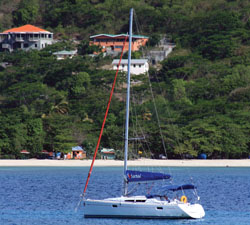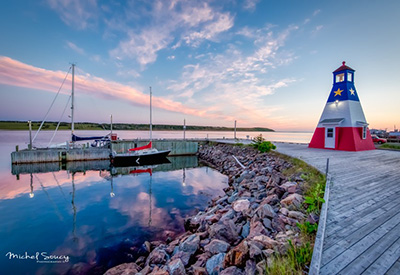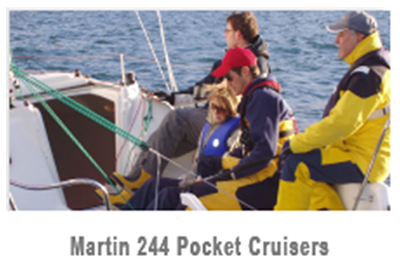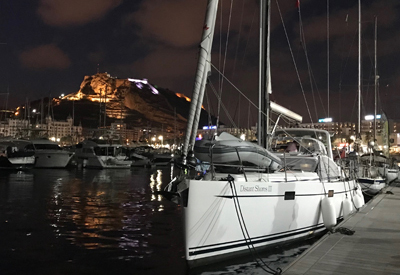North of Desolation Sound – The Broughtons for Beginners
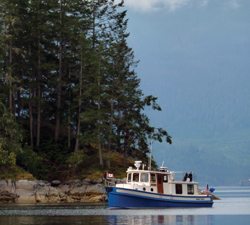
Story & Photos by Mark Bunzel
 The islands, channels and fjords that stretch from Desolation Sound northwest to Queen Charlotte Strait make up one of BC’s most inviting cruising grounds. Here’s how to get there and what to expect.
The islands, channels and fjords that stretch from Desolation Sound northwest to Queen Charlotte Strait make up one of BC’s most inviting cruising grounds. Here’s how to get there and what to expect.
North of Desolation Sound there is a special cruising ground that is rustic, remote and majestic. It offers some of the finest cruising in the world through deep channels and fjords, with vistas of snow-capped mountains beyond. Up here, the cruising just seems to get better the farther north you go.
In addition to surprisingly quiet anchorages, you’ll find small, family-run marina resorts where you’ll have the opportunity to meet many new boating friends. What these marinas may lack in the way of facilities, they more than make up in down-home hospitality and remote, rugged beauty.
The cruising area just north of Desolation Sound is commonly called “The Broughtons” – though the true Broughton Archipelago lies about another 70 miles to the northwest. You could say the Broughtons cruising area starts just north of Desolation Sound and extends to the network of islands above North Broughton Island.
 During the pleasant days of July and August, some of the most popular Desolation Sound anchorages are busy with boats, in sharp contrast to the pristine atmosphere one of the first explorers of this area, Capt. George Vancouver, found in 1792. But just a few miles farther north, the number of boats you see on the water thins out, the scenery gets better and there is more wildlife to see.
During the pleasant days of July and August, some of the most popular Desolation Sound anchorages are busy with boats, in sharp contrast to the pristine atmosphere one of the first explorers of this area, Capt. George Vancouver, found in 1792. But just a few miles farther north, the number of boats you see on the water thins out, the scenery gets better and there is more wildlife to see.
For many cruisers, there seems to be a psychological barrier to venturing beyond Desolation Sound. For some it is the angst of passing safely and comfortably through the challenging tidal rapids that lead to the Broughtons (see “BC Tidal Passes Part 2: Passes Beyond Desolation Sound,” for details on transiting these rapids). Or they worry about a passage on sometimes windy and challenging Johnstone Strait. However, with a little advance preparation, timely weather reports and a good tide and current guide, getting here is really not difficult.
For some, the challenge may lie in the added distance and travel time involved in getting to this special place. While Desolation Sound is 90 to 100 miles north of the population centres of Vancouver and Victoria, the Broughton Archipelago lies another 65 miles north. This can add another day or more to each end of the passage there and back, extending a 10- to 14-day vacation to a three-week cruise.
 Getting There
Getting There
There are two primary routes to cruise to or from the Broughtons, giving you options depending on wind and weather conditions.
The express route heads north to Campbell River; transit Seymour Narrows at slack tide and cruise up Discovery Passage and Johnstone Strait to Havannah Channel. Time your passage for the beginning of an ebb at Seymour Narrows and let the north-flowing current give you a lift. Work the currents to your advantage in Johnstone Strait and turn north up Havannah Channel and into the network of islands that lead to the Broughton Islands group.
If the winds in Johnstone Strait are blowing strongly from the northwest – as they usually do on summer days – right on your nose and against the ebb, you can choose the more protected inside route that starts north of Desolation Sound at Stuart Island and passes through Yuculta Rapids, Gillard Passage and Dent Rapids. This route then follows Cordero Channel.
A third option, also protected and with fewer tidal challenges than the Yucultas and Dents, follows Surge Narrows and Okisollo Channel to Discovery Passage. From there, take Nodales Channel or Mayne Passage to Cordero Channel, or continue along Johnstone Strait.
 The trip from Yuculta Rapids through Gillard Passage offers the option of a special treat with a turn to starboard: an overnight stay at Dent Island Lodge. This is one of the most exclusive resort marinas on the Inside Passage. Its beautiful setting combines with excellent facilities and a choice of a lodge-type dining room or an outdoor tapas bar located along a rushing reversing stream. The food is first-class and the scenery inspiring. Justin and Trish Farr are the managers and hosts, and their staff goes all out to provide a special experience for their guests.
The trip from Yuculta Rapids through Gillard Passage offers the option of a special treat with a turn to starboard: an overnight stay at Dent Island Lodge. This is one of the most exclusive resort marinas on the Inside Passage. Its beautiful setting combines with excellent facilities and a choice of a lodge-type dining room or an outdoor tapas bar located along a rushing reversing stream. The food is first-class and the scenery inspiring. Justin and Trish Farr are the managers and hosts, and their staff goes all out to provide a special experience for their guests.
Cordero Channel
A more casual stop seven miles past Dent Rapids is Shoal Bay Pub and Marina, a government dock and uplands lodge with cabins on East Thurlow Island, run for years by the ambitious Mark McDonald. McDonald has roughed out a laid-back lodge experience at what has been for decades, a stopping point for loggers, fishermen and visiting cruising boats. The view from the Shoal Bay Pub’s deck up Phillips Arm is one of the most beautiful along the passage. If you’re not stopping, look carefully to starboard to see the snow-capped mountains at the end of the arm, or you’ll miss them.
Shoal Bay is one of the “signature” destinations on the passage to the Broughtons. Don’t bother calling ahead on the VHF – the routine here is relaxation. After you find your own space at the dock, venture up to the lodge. Have a beer on the deck and enjoy the view. Or stroll through the garden out back where you are welcome to weed or harvest some lettuce, carrots or tomatoes, depending on the season. If you stop in on a Saturday, Mark and his wife Cynthia may have their outdoor wood-fired pizza oven going. After pizza in the afternoon, guests are welcome to put their own dough into the brick oven for fresh baked bread.
 From Cordero Channel, you can also turn south on Mayne Passage to Blind Channel Resort, run by the Richter family. You can stop for fuel and light provisions, do laundry or enjoy a special dinner with a German flair. Be aware that your wait staff may break into song as they also provide the evening’s charming entertainment between dinner and dessert.
From Cordero Channel, you can also turn south on Mayne Passage to Blind Channel Resort, run by the Richter family. You can stop for fuel and light provisions, do laundry or enjoy a special dinner with a German flair. Be aware that your wait staff may break into song as they also provide the evening’s charming entertainment between dinner and dessert.
Up here, you will quickly realize that cruising is more than just beautiful scenery and wildlife – it’s the people that make it truly special.
From Blind Channel the inside route continues through Greene Point Rapids to Sunderland Channel. Greene Point is another tidal rapids but it has a straight flow and less turbulence than Dent Rapids. Some boats transit Greene Point Rapids at slack and some take the challenge at other times, depending on their experience and the capabilities of their vessel.
Chatham Channel
After traveling through Chancellor, Wellbore and Sunderland channels, the inside route requires passage up Johnstone Strait for about 12 miles. If conditions in the strait are challenging, Port Neville offers refuge. From Johnstone Strait, a turn up Havannah Channel will take you back into protected waters and to Chatham Channel.
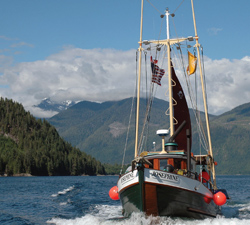 If it’s late in the day and you’re ready to break for the night, visit Port Harvey Marine Resort. George and Gail Cambridge have created a float house marina with docks and the Red Shoe Pub and Restaurant. Bring a red shoe and you get a free dessert. Weather permitting, you can enjoy their sundeck or a fun dinner while you make new friends with the crews of other boats at the docks. Make sure you take a fresh-baked, warm cinnamon bun from the cafe with you for the next day’s passage, although it may not make it far from the dock.
If it’s late in the day and you’re ready to break for the night, visit Port Harvey Marine Resort. George and Gail Cambridge have created a float house marina with docks and the Red Shoe Pub and Restaurant. Bring a red shoe and you get a free dessert. Weather permitting, you can enjoy their sundeck or a fun dinner while you make new friends with the crews of other boats at the docks. Make sure you take a fresh-baked, warm cinnamon bun from the cafe with you for the next day’s passage, although it may not make it far from the dock.
Next, follow Chatham Channel. While the tidal current could be running against you after you turn into the channel, its speed diminishes as the channel widens. It is not turbulent and generally does not have to be traveled at slack.
The next stop on the inside route is at the north end of Chatham Channel, down a narrow but navigable passage (depending on the size of your vessel) called The Blow Hole. Follow the twisting channel down to Lagoon Cove and the Lagoon Cove Marina. Bill and Jean Barber are your hosts at this quaint and relaxing resort marina.
When you arrive, check if there will be a happy hour that day on the deck in front of the old boathouse overlooking the marina. Marina guests bring appetizers to share (see sidebar), and Bill will often bring several buckets of the fresh prawns he catches nearby. You’ll make more friends at Lagoon Cove and by this time you’ll understand what Broughton Islands cruising and socializing is all about. In the evening, there may be a campfire for singing songs or listening to Bill Barber tell of waterskiing bears and other local tall tales. Lagoon Cove Marina also has fuel and water, if it’s time to fill your tanks.
Tribune Channel
You can now choose your direction and pace for Broughton Islands cruising. One popular route is to head north across Knight Inlet and up Tribune Channel. To add to the mystique of the passage, take nearby Sargeaunt Passage. The rock walls in this narrow, deep pass add a dramatic change to the scenery.
From Lagoon Cove, continue north up Tribune Channel about 22 miles to Kwatsi Bay, one of the most beautiful anchorages in the area. Rock walls soar in a bowl around the bay. It takes your breath away. You can anchor in the northern corner in 30 to 80 feet of water, or pull in to the Kwatsi Bay Marina owned by Max Knierin and Anca Fraser.
Max, Anca and their children built the marina floats by felling local logs and adding decking. Over the years this small, intimate resort has expanded with a few more log floats and docks. They have added a gift store, a shower and a covered happy hour area. Thanks to the beauty of Kwatsi Bay and the hospitality of Max and Anca, this is one of the most popular marina resort destinations in the area. It has room for only 16 to 18 boats so moorage reservations by email are highly recommended during the summer months.
Don’t be surprised if Max or Anca personally greet you within moments of your arrival and help you with your lines. Kwatsi Bay Marina is a special place and they work to make everyone feel relaxed and at home. While there, ask for directions to the waterfall or some of the hikes you can take from the shore.
Be prepared as there is often a happy hour appetizer event at Kwatsi Bay around 4 p.m. By now you may be renewing acquaintances with the many new friends you have made along the way, as they also visit the various marinas throughout the Broughtons.
Many cruising boats drop their speed down and just glide through this end of Tribune Channel – the beauty around you is worth it. Just outside Kwatsi Bay and Watson Cove is a unique waterfall called Lacey Falls, right on Tribune Channel. The water descends from high above and fans out across a sheer flat area of black rock. The water here is fairly deep and you can pull almost right up to the rock wall, where you and your crew can enjoy a beautiful and close-up view of the falls.
And you don’t need to spend every night at a marina. The guidebooks can direct you to the many pleasant and secluded anchorages here such as Laura Bay, Simoom Sound, Booker Lagoon, Grappler Sound or Mackenzie Sound. The scenery is extraordinary and you may well be the only boat in your chosen spot.
On the northwest side of Gilford Island is one of the most popular destinations in the Broughtons, Pierre’s Echo Bay Lodge and Marina. Pierre and Tove Landry have taken over the old Echo Bay resort and added their touch to a special Broughton experience.
Pierre built the floating lodge house and floated it into to the bay. He also brought his famous Saturday night pig roasts (reservations recommended) and other food-oriented events such as prime rib Wednesdays – all slow-roasted in their special smoker grill. The events are fun, popular and often have a theme. Check their website (www.pierresbay.com) for the schedule of activities. Pierre’s also has a fuel dock and a small store for provisions.
While at Pierre’s, take the trail to Billy Proctor’s Museum, a fun collection of memorabilia hosted by Billy himself, a local legend. You can also visit Billy’s by boat by anchoring in Shoal Harbour and taking the dinghy. Shoal Harbour is a well-protected overnight anchorage with good crabbing and shrimping nearby.
There are many more places to explore as you continue through the islands. On the north side of North Broughton Island, visit Sullivan Bay for fuel, food, beer and wine. This unique floating resort has docks situated like small streets and lanes, some leading to a neighbourhood of float homes. Check your depth at the dock and you will probably find 150 to 165’. The bays here are deep and the answer is floating docks for stores, restaurants and homes. These floating facilities once serviced the loggers and fisherman of the area and now cater to visiting cruisers. Just don’t drop your keys or sunglasses overboard at the dock.
Homeward Bound
At some point it may be necessary to return to civilization. Many of the resorts here are served by float planes to Vancouver or Seattle. The largest town nearby is Port McNeill on Vancouver Island. Some crews will use Port McNeill as their turn-around point for groceries and fuel. This small town has a little of everything and is well situated for visiting boats. Some crews leave their boats here between trips and fly back and forth to attend to family or business.
When it’s time to return home, you can navigate with a following sea directly down Johnstone Strait, weather and winds permitting. Stops are possible at the charming village of Sointula or at Alert Bay, site of the U’mista Cultural Centre, a Kwakwa_ka_’wakw First Nations museum. Historic Telegraph Cove could also be a stop. Or head back into the islands and return home along the protected inside route.
The Broughton Islands are a dream destination for cruising. Highlights include pleasant passages through amazing scenery and the warmth of family-run resorts that are dedicated to hospitality. The laid-back spirit is infectious. You will inevitably make many new friends on your cruising adventure and, like many cruisers, you’ll want to return again and again.
Mark Bunzel is editor/publisher of the Waggoner Cruising Guide (WaggonerGuide.com). Each summer he cruises the Broughton Islands and the entire coast between Olympia, Washington and Ketchikan, Alaska to gather updates for the guide. He is also the publisher of Fine Edge Nautical Publishing, a source of many cruising guides and maps for northwest and southeast Alaska cruising.
Planning for Happy ‘Appy’ Hour
…or how to cope when Oreos just won’t cut it.
The primary social gathering when cruising in the Broughtons revolves around Happy Hour. This is a ritual in many northwest cruising areas, held at around 4 p.m. I am told there’s a movement afoot at some marinas to move this time up to 3 p.m., or maybe sometime after lunch. If a Happy Hour is not scheduled, it could simply be completely impromptu when a group of boaters are hanging around the dock and someone says, “Hey – we ought to have a Happy Hour!”
During our early years of cruising the Inside Passage, I never seemed to have the right provisions to make a proper Happy Hour contribution. It was embarrassing to show up with a plate of store-bought Oreo cookies, though I will admit the Oreos always disappeared. No one had briefed us on this ritual.
Now I try to be much better prepared, starting right at the beginning of cruising season. In addition to making sure we have an adequate supply of oil, filters and belts, I stock plenty of standby items for whipping up a jaw-dropping, memorable Happy Hour hors d’oeuvre, preferably something that will stack or mound up to eight inches high or more.
What’s my secret? Cream cheese and a good supply of crackers!
When I stock the boat, I make a special trip to my local warehouse store for large quantities of cream cheese and mixed crackers, boxes of them. I stock onion soup mix, various pre-packaged spice combinations, canned smoked salmon, canned crab and even canned shrimp. Just in case I end up cruising to multiple locations with the same people, I also have a number of sweet mixes for cream cheese to change things up. Dried cherries, cranraisins, dried apricots and a few syrups add colour and flavour. My fellow cruisers love them!
My cream cheese adaptations generally go over well but I have noticed that some captain and first mate teams look for extra points in the unspoken Happy Appy competition. They bring a dip made of fresh-caught crab (sometimes even arranged in the shell) with plenty of chunk crab meat. Or they show up with a bowl of fresh prawns caught just that morning and still warm from a spiced boil. And I really hate the guy who shows up with the salmon he caught that morning and hot-smoked on the dock next to his boat. How does he do this? He is one competitive Happy Hour cruiser.
The benefits to the Happy Hour are many. I long for pea salad like my mother used to make, or the spicy coleslaw someone brings in a classic antique bowl. How about a simple green salad with fresh tomatoes brought over from Vancouver Island, garnished with almonds. Fresh brownies are a wonderful contribution and yes, I might even sneak an Oreo cookie or two when one of the newbies joins the party on the dock.
Be ready and go bold for Happy Hour!
First Mate, MV Potluck
If You Go
Dent Island Lodge
www.dentisland.com
Shoal Bay Pub & Marina
web.mac.com/shoalbay/Site/Welcome.html
Blind Channel Resort
www.blindchannel.com
Port Harvey Marine Resort
www.portharvey.blogspot.ca/
Lagoon Cove Marina
www.lagooncovemarina.com
Kwatsi Bay Marina
www.kwatsibay.com
Pierre’s Echo Bay Lodge & Marina
www.pierresbay.com
Sullivan Bay Marine Resort
www.sullivanbay.com
Port McNeill
www.portmcneill.net
Port McNeill Marina & Fuel Dock
www.portmcneill.com
U’mista Cultural Centre
www.umista.ca
Telegraph Cove
www.telegraphcove.ca
Photo Captions:
Photo 1 – A classic Nordic Tug sits quietly at anchor in Port Harvey with the mountains of Vancouver Island on the horizon across Johnstone Strait.
Photo 2 – Even on a misty morning, the view from the dock at Kwatsi Bay carries a quiet and majestic beauty.
Photo 3 – The view up Phillips Arm from the Shoal Bay dock is breathtaking and one of many reasons cruising in this area is so special.
Photo 4 – Local legend Billy Proctor recently completed a replica of a simple logger’s cabin at Billy’s Museum in Shoal Harbour.
Photo 5 – The old boathouse is the place to be when happy hour begins at the Lagoon Cove Marina. Get there before they run out of Bill Barber’s fresh-caught prawns.
Photo 6 – The classic converted troller Josephine works her way up Cordero Channel on a sunny day, en route to the Broughtons.

